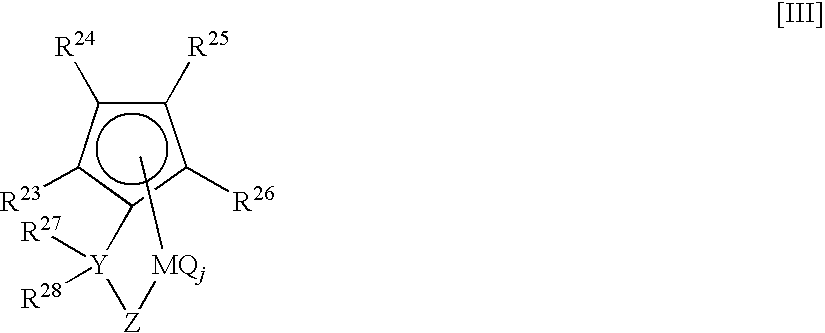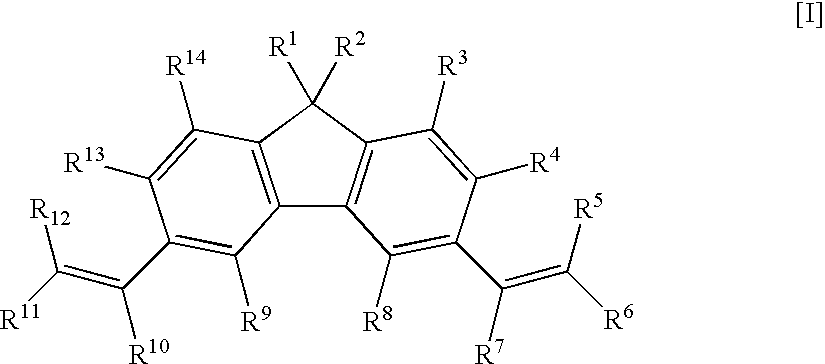Fluorene derivative, transition metal compound, catalyst for olefin polymerization, and process for producing olefin polymer
a technology of transition metal compound and fluorene derivative, which is applied in the direction of chemical/physical processes, group 4/14 element organic compound, silicon organic compound, etc., can solve the problems of inability to synthesise fluorene derivatives, no reported examples of fluorene derivative synthesis, and inability to achieve high activity
- Summary
- Abstract
- Description
- Claims
- Application Information
AI Technical Summary
Benefits of technology
Problems solved by technology
Method used
Image
Examples
example 1
1,1,3,6,8,8-hexamethyl-1H,8H-dicyclopenta[b,h]fluorene
[0145]To a 300-ml three-neck flask, 25.8 g of anhydrous aluminum chloride, 5.18 g of fluorene, and 200 ml of carbon disulfide were charged under nitrogen atmosphere. 6.18 g of mesityl oxide was added dropwise thereto over 15 minutes in a water bath, and the mixture was stirred for 10 hours under reflux. After standing to cool, 100 ml of water was added thereto, and the organic layer was separated. The aqueous layer was extracted with 300 ml of hexane, and the separated organic layer was combined, and washed with water and a saturated aqueous solution of sodium chloride. After the solution was dried over magnesium sulfate, the solvent was distilled off, and the obtained product was purified by column chromatography, and recrystallized with a mixed solvent of ethanol / hexane. The yield was 1.14 g. Identification was performed by 1H-NMR spectrum. The measurement results are shown as follows.
[0146]1H-NMR (270 MHz, CDCl3, TMS standard)...
example 2
(Phenyl)(methyl)methylene(3-tert-butyl-5-methylcyclopentadienyl)(1,1,3,6,8,8-hexamethyl-1H,8H-dicyclopenta[b,h]fluorenyl)zirconium dichloride
(1) Synthesis of 3-tert-butyl-6-phenyl-1,6-dimethyl-fulvene
[0147]To a 100-ml three-neck flask, 1.50 g of potassium hydroxide pulverized in mortar, 0.91 g of 18-crown-6 and 45 ml of THF were charged under nitrogen atmosphere. 2.70 g of t-butyl-methylcyclopentadiene was added dropwise thereto over 10 minutes in a water bath, and the mixture was stirred for 3 hours. The solution was added with 11.33 g of acetophenone dropwise over 10 minutes, and the mixture was stirred for 22 hours. The reaction solution was poured into 100 ml of 2N hydrochloric acid. The organic layer was separated, and the aqueous layer was extracted with 200 ml of hexane. The separated organic layers were combined, and washed with a saturated aqueous solution of sodium hydrogen carbonate, water, and a saturated aqueous solution of sodium chloride. After the solution was dried ...
example 3
Preparation of Supported Catalyst
[0154]To a 100-ml three-neck flask, which had been thoroughly purged with nitrogen, and equipped with a stirring rod, 1.00 g of silica-supported methylaluminoxane (Al=14.6 wt %) was added. 10 ml of dehydrated toluene was added thereto at room temperature, 20 ml of a toluene solution of 21.0 mg of the (phenyl)(methyl)methylene(3-tert-butyl-5-methylcyclopentadienyl)(1,1,3,6,8,8-hexamethyl-1H,8H-dicyclopenta[b,h]fluorenyl)zirconium dichloride synthesized by the above-mentioned Example 2 was added as a transition metal compound under stirring, and the mixture was stirred for 1 hour. The obtained slurry was filtered, and powder on the filter was washed once with 10 ml of dehydrated toluene, and subsequently washed three times with 10 ml of dehydrated hexane. The washed powder was dried under reduced pressure for 2 hours to obtain 0.934 g of powder. The obtained powder was mixed with 8.41 g of a mineral oil to obtain a 10.0 wt % slurry.
PUM
| Property | Measurement | Unit |
|---|---|---|
| temperature | aaaaa | aaaaa |
| temperature | aaaaa | aaaaa |
| temperature | aaaaa | aaaaa |
Abstract
Description
Claims
Application Information
 Login to View More
Login to View More - R&D
- Intellectual Property
- Life Sciences
- Materials
- Tech Scout
- Unparalleled Data Quality
- Higher Quality Content
- 60% Fewer Hallucinations
Browse by: Latest US Patents, China's latest patents, Technical Efficacy Thesaurus, Application Domain, Technology Topic, Popular Technical Reports.
© 2025 PatSnap. All rights reserved.Legal|Privacy policy|Modern Slavery Act Transparency Statement|Sitemap|About US| Contact US: help@patsnap.com



